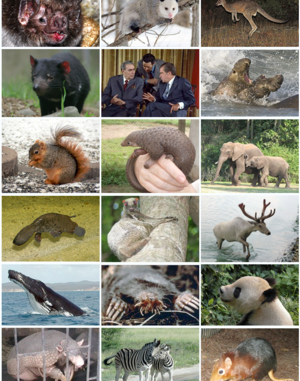
Natural history:
- Mammals are primarily terrestrial vertebrates but few like whales and dolphins are aquatic.
- They are the most dominant animals on earth and have the capacity to learn because of their better developed brain.
- Mammals have evolved from Therapsid (mammals-like) reptiles some 220 million years ago in the Triassic period.
Appendages:
- There are two pairs of pentadactyl limbs (each foot bears 5 or fewer toes provided with horny claws, nails or hooves).
- They are variously adapted for walking, running, jumping, climbing, burrowing, swimming, flying etc.
Skin:
- The skin is glandular (sweat glands, sebum glands etc.) and mostly covered by a horny epidermal exoskeleton of hair and fur.
- The hair on the skin and adipose tissue beneath the skin conserve body heat.
- Mammary glands are well developed in females that produce milk to suckle the young ones.
Digestive system:
- The mouth is relatively small and has movable lips.
- Buccal cavity has true salivary glands.
- Teeth occur in both the jaws and they are thecodont (developed in sockets) and heterodont (different types of teeth growing in two sets).
- Tongue is mobile.
- Distinct liver and pancreas are present.
- Alimentary canal is complete and opens by anus.
Respiratory system:
- Respiration occurs only by lungs which are elastic and spongy.
- They are enclosed in the pleural cavities.
- Rib muscles and diaphragm (a muscular partition separating thoracic cavity from abdominal cavity) play a role in breathing.
- Glottis is guarded by epiglottis.
Circulatory system:
- The circulatory system is closed.
- The heart is four chambered with two auricles and two ventricles.
- Heart pumps oxygenated blood to different parts of the body.
- Hepatic portal system is present but renal portal system is
- RBCS are circular, biconcave and non-nucleated most species.
- They are homeothermic (warm-blooded), which gives them high rate of metabolism and makes them active.
Nervous system:
- The brain has large cerebrum and cerebellum.
- There are 12 pairs of cranial nerves and 31 pairs of spinal nerves.
- Optic lobes are divided into four bodies; corpora quadrigemina.
- Corpus callosum connects the two cerebral hemispheres.
Sense organs:
- The olfactory sacs open by the internal nares far back into the pharynx.
- Eyes have movable lids.
- Internal ear has an organ of corti, middle ear has 3 bony ear osciles (malleus, incus and stapes) and external ear generally has a large, fleshy pinna.
Excretory system:
- Two bean shaped kidneys are present which are metanephric.
- They are ureotelic (excrete urea).
- Ureters open into the urinary bladder and urine is fluid.
Reproductive system:
- Sexes are often distinguishable externally (sexual dimorphism).
- The testes usually descend into scrotal sacs in the adult.
- Male has a copulatory organ called penis.
- Gonoducts lead directly to the exterior and fertilization is internal.
- Mammals are mostly viviparous (directly give birth to the young ones).
- Development occurs in the uterus of the female. Embryo has amnion, allantois and chorion.
- A placenta fixes the fetus to the uterine wall for nourishment, respiration and excretion.
- Young ones are nourished with milk for some time after birth and are brought up with great love and care.